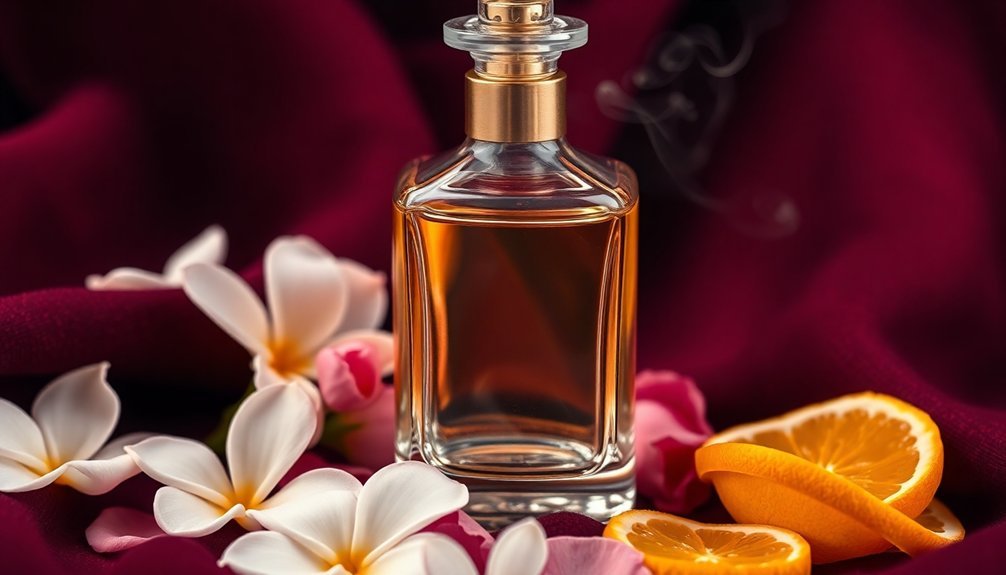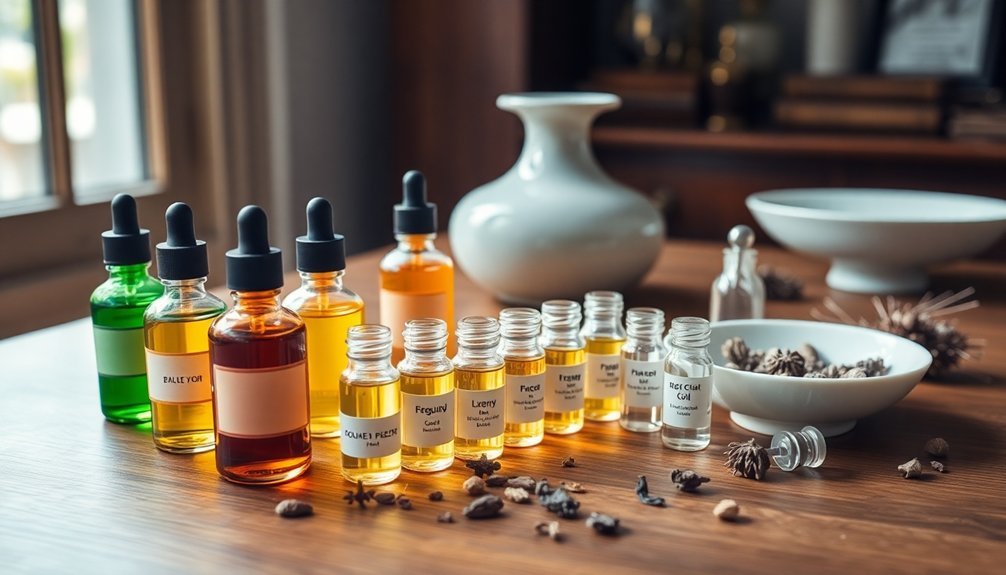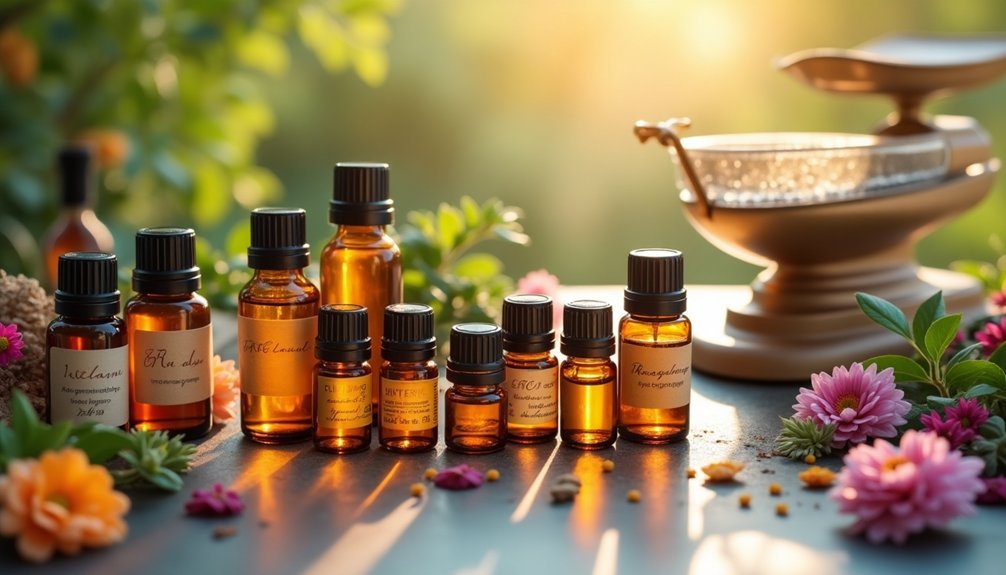The three most effective fragrance note ratios for your custom perfume are the classic 30-45-25 blend (30% top notes, 45% middle notes, 25% base notes), the seasonal ratio that adjusts for summer (35-45-20) and winter (25-35-40), and the precise drop-by-drop method starting with equal parts of 2-3 materials. You'll find these ratios provide a solid foundation for creating balanced scents, whether you're crafting a light summer fragrance or a deep winter perfume. Understanding the nuances of each approach will transform your perfume-making journey.
Classic 30-45-25 Ratio: The Timeless Perfume Formula

When creating a custom perfume, understanding the classic 30-45-25 ratio acts as your fundamental blueprint for success. This time-tested formula divides your fragrance into three essential components: 30% top notes, 45% middle notes, and 25% base notes.
You'll want to start with top notes like citrus and spices that create the initial impression but quickly evaporate. Small batch testing before scaling up your formula helps ensure your chosen scent combinations work well together.
The middle notes, making up the largest portion at 45%, form your perfume's heart with florals and fruits that mask the early base note scents.
Finally, you'll need 25% base notes, including rich ingredients like vanilla or patchouli, to provide lasting power and depth.
While you can adjust these percentages to suit your preferences, this ratio guarantees a well-balanced fragrance that evolves beautifully over time.
Seasonal Scent Ratio: Adjusting Notes for Summer and Winter
Just as nature adapts to changing seasons, your perfume ratios should shift between summer and winter to create the most fitting fragrances.
For summer blends, aim for a lighter 35-45-20 ratio, emphasizing top and heart notes while minimizing base notes. Focus on citrus, light florals, and marine notes in the top layer, followed by fresh wildflowers and tropical scents in the heart, with just a touch of light musk or amber at the base. Incorporating notes like honeysuckle and cherry blossom creates that perfect summer brightness.
Winter fragrances work best with a deeper 25-35-40 ratio, allowing base notes to dominate. Start with spicy and smoky top notes, change to rich florals and gourmands in the heart, and anchor the scent with substantial amounts of musk, resins, and woody notes at the base.
This creates the warm, long-lasting profile winter demands.
Drop-by-Drop Method: Building Your Custom Perfume Blend

Moving from seasonal ratios to hands-on creation, the drop-by-drop method offers precise control over your custom perfume composition. You'll start by selecting 2-3 key materials in equal proportions, then fine-tune them until you achieve harmony. Next, add your modifiers carefully, one drop at a time, testing after each addition. Using standardized droppers or pipettes ensures accurate measurements when creating your blend.
| Step | Action | Key Point |
|---|---|---|
| 1 | Form Base | Mix 2-3 materials equally |
| 2 | Modify | Add fresh/clean notes carefully |
| 3 | Harmonize | Use blenders like lavender |
For depth, you'll incorporate fixatives following the 25-45-30 ratio (base, middle, top notes). Remember to document each addition in your notebook, as this helps track your progress and maintain consistency. If you overdose a modifier, don't hesitate to start fresh – precision is essential for achieving your desired scent profile.
Frequently Asked Questions
How Do Humidity Levels Affect Fragrance Note Ratios in Different Climates?
You'll need more base notes in dry climates since fragrances evaporate quickly, while humid environments require lighter top notes. Adjust your ratios to include 10-20% more base notes in arid conditions.
Can Certain Note Combinations Cause Headaches or Allergic Reactions?
Yes, you'll find certain note combinations can trigger headaches and allergies, especially if you're sensitive to heavy florals, synthetic musks, or concentrated aldehydes. Consider testing small amounts before full application.
What's the Ideal Ratio for Creating Unisex Fragrances?
You'll want to aim for 30% top notes, 50% middle notes, and 20% base notes in your unisex fragrance. This balanced ratio guarantees the scent appeals equally to all genders while maintaining longevity.
How Do Natural vs. Synthetic Ingredients Impact Recommended Ratios?
You'll need more top notes (35-40%) with natural ingredients since they're less stable. With synthetics, you can use lower concentrations (20-25%) of top notes since they last longer and project better.
Should Ratios Change When Creating Solid Perfumes Versus Liquid Ones?
You'll need higher essential oil concentrations in solid perfumes – around 30% versus 20% in liquids. The wax base affects scent diffusion, so you should increase your fragrance ratios accordingly.
In Summary
You've now got the essential tools to create your own signature scent. Whether you stick to the classic 30-45-25 ratio, adjust your notes seasonally, or build your fragrance drop by drop, remember that perfumery is both an art and a science. Don't be afraid to experiment with these ratios as starting points. Trust your nose, keep detailed notes of your blends, and you'll soon master the art of custom perfume creation.





Leave a Reply